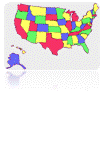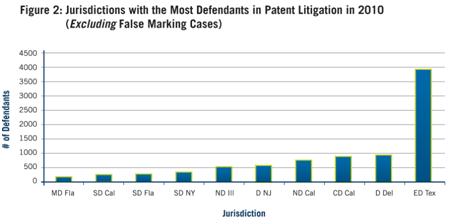Radio Systems Corp. v. Accession, Inc. (Fed. Cir. 2011) – Part III
The jurisdiction of US Federal Courts is limited in several important ways. One usual doctrinal divide is between subject matter jurisdiction and personal jurisdiction. Because patent enforcement is clearly a matter a Federal Law, the subject matter jurisdiction question normally boils down to whether an “actual case or controversy” exists between the parties as required by Article III of the US Constitution (as interpreted). In MedImmune, the Supreme Court suggested that this actual case or controversy inquiry should be flexible and open.
Personal jurisdiction is a separate question and asks whether a court holds power over the actual parties to the lawsuit. Because plaintiffs are deemed to waive personal jurisdiction objections in the filing of the complaint, the more usual question is whether the court holds power over the defendants to a lawsuit.

The usual approach is to look at the extent of the defendant’s contacts with the state and consider whether those meet some minimum threshold level. Normally, each state is seen as a separate entity. Thus, contacts with Mississippi will not give rise to personal jurisdiction across the border in Tennessee. Under the doctrine of Specific Jurisdiction, contacts with the forum state that relate directly to the controversy between the parties tend to be more likely to create personal jurisdiction. However, sufficient unrelated contacts with the forum state can separately lead to a finding of personal jurisdiction under a the doctrine of General Jurisdiction. A final important point is that the jurisdiction tests are separate and distinct from the venue inquiry. Thus, even when a court properly has jurisdiction over a case and the parties, it may still refuse to hear the case based on arguments of improper or inconvenient venue. See TS Tech.
In the case at hand, Radio Systems sued Accession in the Eastern District of Tennessee – asking the court for a declaratory judgment that Accession’s patent was invalid and not infringed. The district court dismissed the case – holding that the Federal Court based in Tennessee lacked personal jurisdiction over Accession. On appeal, the Court of Appeals for the Federal Circuit affirmed.
Accession is a small New Jersey based private corporation. Mr. Sullivan owns the company. He is also the company’s sole employee. During a three year period prior to the declaratory judgment lawsuit, Sullivan contacted Radio Systems on multiple occasions looking to create a business relationship between the parties. The contacts involved letters, e-mails, telephone calls and one trip to Radio Systems’ main office in Tennessee where Sullivan demonstrated his product. (At the face-to-face meeting, Sullivan refused to leave his prototype behind, but did sign a non-disclosure agreement that included Tennessee as the exclusive forum for actions arising from the non-disclosure agreement). There is plenty of evidence that the proposed business relationship would center on the manufacturing and marketing of Mr. Sullivan patented invention – a pet-entrance module for sliding glass patio doors. However, there is no evidence that Sullivan threatened a lawsuit or that Radio Systems challenged the validity of the Sullivan patent during any of the meetings. As a side-show, after it was clear that no deal was going to happen, Sullivan’s patent attorney contacted the USPTO as an informal protest to one of Radio Systems’ pending patent applications. In September 2009, Accession’s counsel also sent letters to Radio Systems “outlining Accession’s infringement allegations and suggesting that the dispute be settled through a licensing agreement.” In November 2009, Radio Systems then filed the declaratory judgment lawsuit in Tennessee.
In its want to lay down clear guidance, the Federal Circuit has previously ruled that “ordinary cease-and-desist notices sent by a patentee to an alleged infringing party in a different state are not sufficient to subject the patentee to specific jurisdiction in that state.” Rather, for a finding of specific personal jurisdiction, the infringement-alleging letter must be accompanied by some other activities related to the allegations that are directed to the forum state. See Autogenomics, Inc. v. Oxford Gene Tech. Ltd., 566 F.3d 1012, 1019 (Fed. Cir. 2009). As a dividing line for specific jurisdiction, the Federal Circuit only “counts” activities related to enforcement of the patent or defenses against infringement. Other activities directed at the forum state that are merely related to the licensing, marketing, manufacturing or development of the invention do not count toward a finding of specific personal jurisdiction. As the court wrote in Autogenomics:
[O]nly enforcement or defense efforts related to the patent rather than the patentee’s own commercialization efforts are to be considered for establishing specific personal jurisdiction in a declaratory judgment action against the patentee.
The court held that interference with Radio Signal’s pending application at the USPTO does not bolster the claim for personal jurisdiction in Tennessee because the USPTO is not located in Tennessee (even though Radio Signal owns its patents in Tennessee).
We made clear in Avocent that enforcement activities taking place outside the forum state do not give rise to personal jurisdiction in the forum, and that decision is controlling here.
Radio Systems did not claim a violation of the non-disclosure agreement, but argued that Sullivans agreement to be subject to personal jurisdiction in Tennessee for actions arising from that agreement should be sufficient fair warning to Sullivan that his company may be subject to action in Tennessee. The Federal Circuit rejected that argument because the agreement did not relate directly to the enforcement or validity of the patent at issue but rather only involved the subject matter of the invention and potential commercialization of the invention.
Finding of no personal jurisdiction affirmed. Federal Courts in Tennessee courts have no jurisdiction over Accession for this patent non-infringement action.
